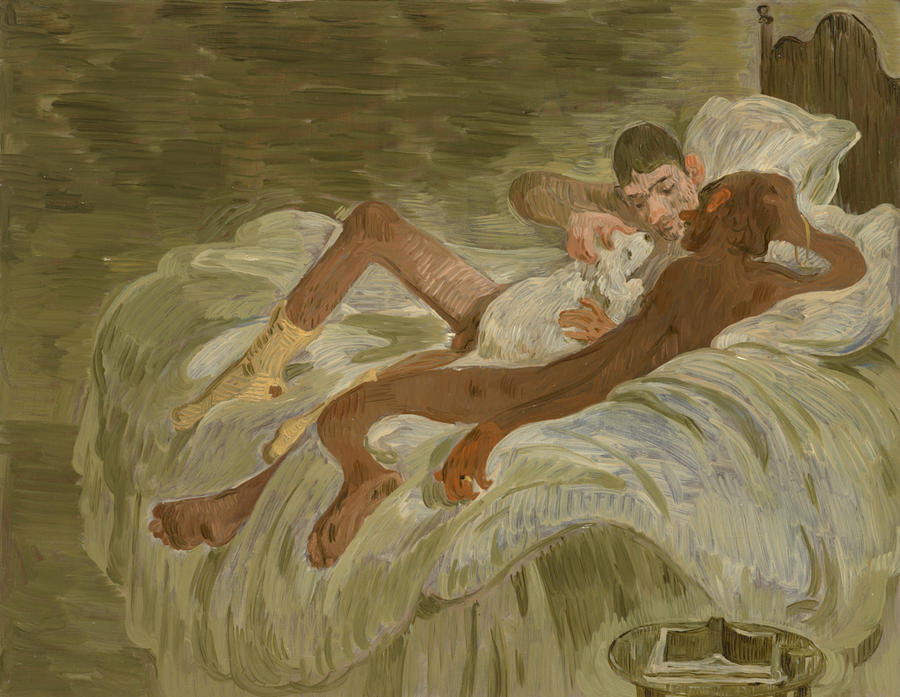On Salman Toor’s Two Boys with a Dog
Angelina Rodgers
→BFA PT 2025

In Salman Toor’s Two Boys with a Dog, 2020, the artist depicts two men lounging in a bed, playing with a white dog, with a book placed open and face-down on a side table in the foreground. Through attention to brushstrokes, color, and intimate scale, Toor—a queer artist exhibiting alongside other queer/POC artists—creates a scene of uncensored, ephemeral, and universal love.
The love depicted in Two Boys with a Dog is more universal than specific, despite the strides it makes in queer/POC representation. Toor recognizes “the extraordinary importance of all expressions of intimacy as fundamental and equal,” as stated by the curators of Any distance between us, Stephen Truax and Dominic Molon. Overlooking all subjective biases, Two Boys with a Dog communicates love: the most essential, deep, and intimate of human feelings.
Toor’s brushstrokes are staccato-like and linear, yet voluminous; diagrammatic, yet organic. They contour the forms and establish the multiplanar surface of the bed the men lay on. Many of the strokes bounce off the edges of forms, creating a sense of dialogue between the forms. The brushstrokes recall Impressionism, which sought to depict the world through a subjective and immediate lens.
Toor achieves this effect not through buoyant pastels and windswept clouds, but through curvilinear strokes, evoking a sensual tangling of bodies and a playful moment of closeness. With close cropping, the scene is personal and ephemeral, suggestive of tiny movements or changes in the near future. The book propped open on the side table also exists in a frozen state of transition, its contents unknown to the viewer. This inaccessibility provides a sense of anticipation; we know not what will come, and therefore can relish in this singular snapshot of time.
Toor also takes care in his color choice and scale, using them to highlight the intimate mood of the scene. The colors are neutral, leaning towards a green spectrum that creates a warm glow. He stirs compassion by focusing the direction of the light on the faces of both men and in the space they share with the dog. The scale is small, tangible, and enticing, physically drawing in the viewer.
As Audre Lorde writes in her 1984 essay “The Uses of the Erotic, The Erotic as Power,” the erotic functions to provide power, which derives from “sharing deeply any pursuit with another person. The sharing of joy, whether physical, emotional, psychic, or intellectual, forms a bridge between the sharers, which can be the basis for understanding much of what is not shared between them.” While the men are naked, potentially suggesting a sexual context, Toor’s portrayal of their nakedness invokes feelings of warmth and humility rather than lust. Two Boys with a Dog expresses Lorde’s idea by attracting a contemplation of the men’s non-sexual eroticism.
Shown in Any Distance Between Us, a queer/POC-dominated exhibit, this piece may appeal to young, queer, POC people. The portrayal of non-white gay men allows for a discussion of representation—especially one of intersectionality—in marginalized communities. Despite the artist’s specificity of the characters’ relationship regarding sexuality and race, their love is universal, and can be interpreted as tender and intimate by an audience of any age, gender, or sexual expression. Seeing work like Toor’s displayed among others like it enlivens me through the RISD Museum’s efforts to exhibit artists who have been historically marginalized. But it is also disheartening to see this piece nestled in a gallery space potentially overlooked by those museum goers less disposed to spend time in a POC/LGBTQ-dominated exhibition.
I was inclined to analyze Toor’s piece because of my position as a queer, mixed-race woman. Two Boys with a Dog represents those parts of my identity I wish others would take more time to empathize with. I am half Finnish and half Dominican. Having been raised in a culturally white-dominated family due to my father’s absence, my positionality reflects the white half of my identity that I have had the opportunity to embrace. Reading the work from an external lens also reveals to me the concepts that I need to work to unlearn, like internalized homophobia and racism. I interpreted Toor’s piece as a commentary on queerness, but also on interracial relationships being opportunities for growth, learning, and unconditional love.
Angelina Rodgers has been interested in art writing since taking AP Art History in high school; she also writes poetry and has performed in spoken word competitions for Poetry Out Loud and Louder Than a Bomb in Delray Beach, Florida.